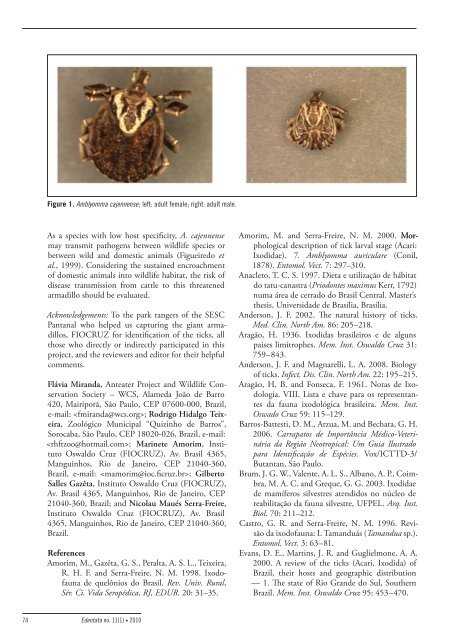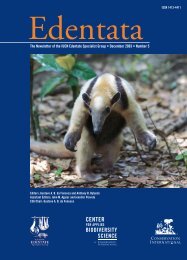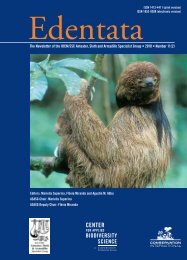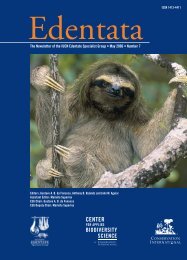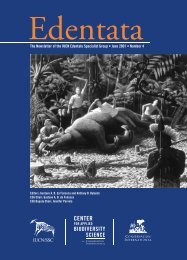Edentata 11(1) - Anteater, Sloth & Armadillo Specialist Group
Edentata 11(1) - Anteater, Sloth & Armadillo Specialist Group
Edentata 11(1) - Anteater, Sloth & Armadillo Specialist Group
You also want an ePaper? Increase the reach of your titles
YUMPU automatically turns print PDFs into web optimized ePapers that Google loves.
Figure 1. Amblyomma cajennense; left: adult female; right: adult male.<br />
As a species with low host specificity, A. cajennense<br />
may transmit pathogens between wildlife species or<br />
between wild and domestic animals (Figueiredo et<br />
al., 1999). Considering the sustained encroachment<br />
of domestic animals into wildlife habitat, the risk of<br />
disease transmission from cattle to this threatened<br />
armadillo should be evaluated.<br />
Acknowledgements: To the park rangers of the SESC<br />
Pantanal who helped us capturing the giant armadillos,<br />
FIOCRUZ for identification of the ticks, all<br />
those who directly or indirectly participated in this<br />
project, and the reviewers and editor for their helpful<br />
comments.<br />
Flávia Miranda, <strong>Anteater</strong> Project and Wildlife Conservation<br />
Society – WCS, Alameda João de Barro<br />
420, Mairiporã , São Paulo, CEP 07600-000, Brazil,<br />
e-mail: ; Rodrigo Hidalgo Teixeira,<br />
Zoológico Municipal “Quizinho de Barros”,<br />
Sorocaba, São Paulo, CEP 18020-026, Brazil, e-mail:<br />
; Marinete Amorim, Instituto<br />
Oswaldo Cruz (FIOCRUZ), Av. Brasil 4365,<br />
Manguinhos, Rio de Janeiro, CEP 21040-360,<br />
Brazil, e-mail: ; Gilberto<br />
Salles Gazêta, Instituto Oswaldo Cruz (FIOCRUZ),<br />
Av. Brasil 4365, Manguinhos, Rio de Janeiro, CEP<br />
21040-360, Brazil; and Nicolau Maués Serra-Freire,<br />
Instituto Oswaldo Cruz (FIOCRUZ), Av. Brasil<br />
4365, Manguinhos, Rio de Janeiro, CEP 21040-360,<br />
Brazil.<br />
References<br />
Amorim, M., Gazêta, G. S., Peralta, A. S. L., Teixeira,<br />
R. H. F. and Serra-Freire, N. M. 1998. Ixodofauna<br />
de quelônios do Brasil. Rev. Univ. Rural,<br />
Sér. Ci. Vida Seropédica, RJ, EDUR. 20: 31–35.<br />
Amorim, M. and Serra-Freire, N. M. 2000. Morphological<br />
description of tick larval stage (Acari:<br />
Ixodidae). 7. Amblyomma auriculare (Conil,<br />
1878). Entomol. Vect. 7: 297–310.<br />
Anacleto, T. C. S. 1997. Dieta e utilização de hábitat<br />
do tatu-canastra (Priodontes maximus Kerr, 1792)<br />
numa área de cerrado do Brasil Central. Master’s<br />
thesis, Universidade de Brasília, Brasília.<br />
Anderson, J. F. 2002. The natural history of ticks.<br />
Med. Clin. North Am. 86: 205–218.<br />
Aragão, H. 1936. Ixodidas brasileiros e de alguns<br />
paises limitrophes. Mem. Inst. Oswaldo Cruz 31:<br />
759–843.<br />
Anderson, J. F. and Magnarelli, L. A. 2008. Biology<br />
of ticks. Infect. Dis. Clin. North Am. 22: 195–215.<br />
Aragão, H. B. and Fonseca, F. 1961. Notas de Ixodologia.<br />
VIII. Lista e chave para os representantes<br />
da fauna ixodológica brasileira. Mem. Inst.<br />
Oswado Cruz 59: <strong>11</strong>5–129.<br />
Barros-Battesti, D. M., Arzua, M. and Bechara, G. H.<br />
2006. Carrapatos de Importância Médico-Veterinária<br />
da Região Neotropical: Um Guia Ilustrado<br />
para Identificação de Espécies. Vox/ICTTD-3/<br />
Butantan, São Paulo.<br />
Brum, J. G. W., Valente, A. L. S., Albano, A. P., Coimbra,<br />
M. A. C. and Greque, G. G. 2003. Ixodidae<br />
de mamíferos silvestres atendidos no núcleo de<br />
reabilitação da fauna silvestre, UFPEL. Arq. Inst.<br />
Biol. 70: 2<strong>11</strong>–212.<br />
Castro, G. R. and Serra-Freire, N. M. 1996. Revisão<br />
da ixodofauna: I. Tamanduás (Tamandua sp.).<br />
Entomol. Vect. 3: 63–81.<br />
Evans, D. E., Martins, J. R. and Guglielmone, A. A.<br />
2000. A review of the ticks (Acari, Ixodida) of<br />
Brazil, their hosts and geographic distribution<br />
— 1. The state of Rio Grande do Sul, Southern<br />
Brazil. Mem. Inst. Oswaldo Cruz 95: 453–470.<br />
74<br />
<strong>Edentata</strong> no. <strong>11</strong>(1) • 2010


